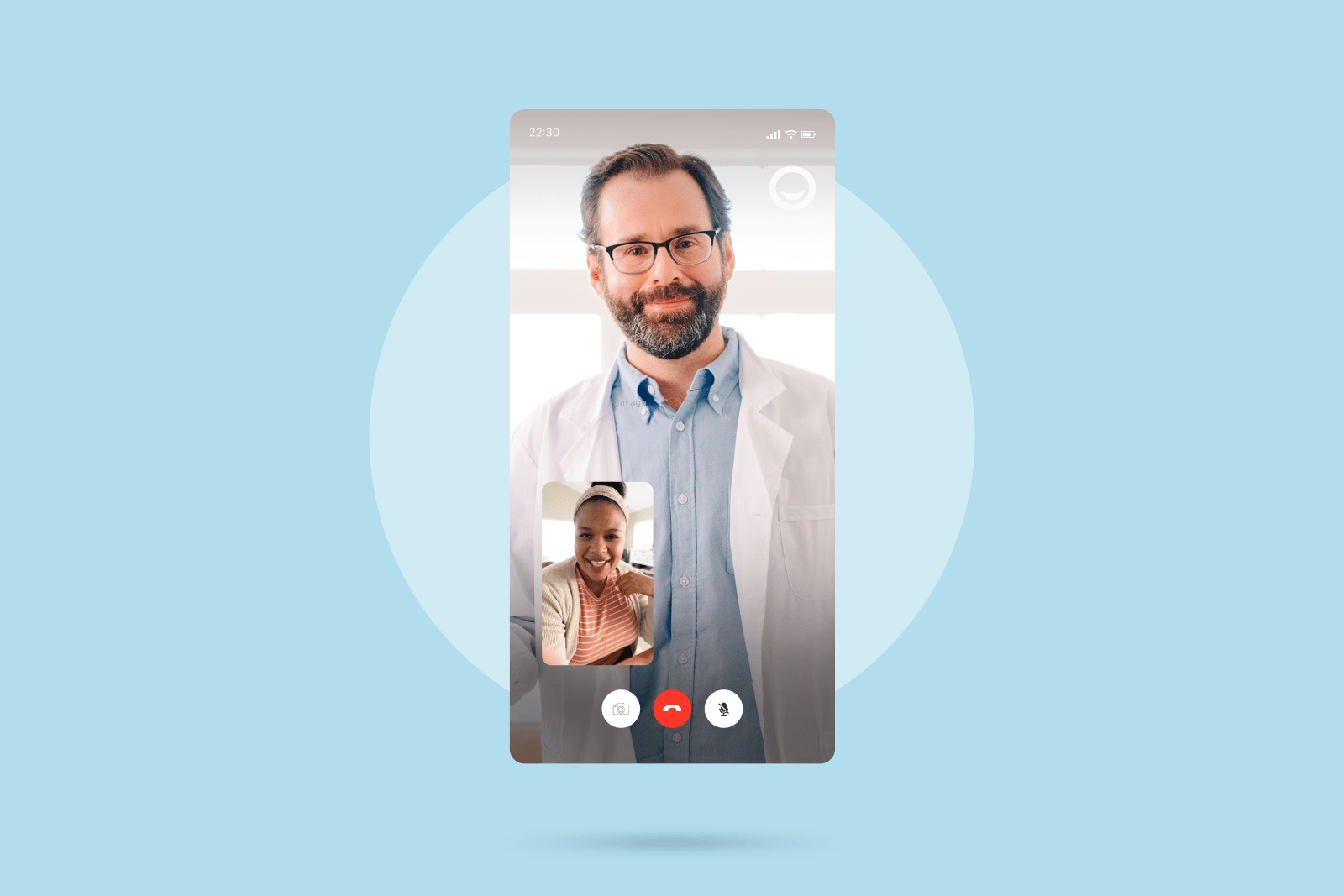
Back pain treatment available online today
In order to treat your back pain, consult with one of our board-certified doctors online today to discuss a treatment plan to help relieve your back pain. If needed, get a new prescription to treat back pain or refill an existing prescription today.*

*Prescriptions are provided at the doctor's discretion. Learn more about our controlled substances policy and how to save up to 80% with our prescription discount card. PlushCare doctors cannot treat all cases of back pain. Our primary care physicians can conduct an initial evaluation of your symptoms but may need to refer you to a specialist or for in-person treatment. If you are experiencing life-threatening symptoms, seek emergency medical attention immediately.
Learn about back pain
Back pain is categorized as discomfort in the back. Back pain is often described as painful muscle spasms and can last any time. Doctors describe back pain that lasts less than 4 weeks as acute back pain, and back pain that lasts more than 12 weeks is called chronic back pain. Chronic low back pain is often felt with tight muscles and is characterized as a painful area in the lower back region of your body.
Back pain causes
Many different factors can cause back pain, and the pain can feel different for different people. People often refer to "throwing out" their backs when they strain one or more muscles in their back. Straining your back muscles can be extremely painful. Most back pain is caused by what doctors call nonspecific back pain, and is rarely caused by a disease, specific abnormality, serious spinal injury, or neurological disorders. Nonspecific back pain occurs in many people who report back pain. Doctors have been able to identify known causes that make back pain worse.
Muscle sprains
Back pain can be caused by muscle sprains resulting from heavy lifting, sudden movements, shoveling, or bending over. Sudden movements can trigger a sudden onset of pain. This type of pain is usually related to a strain in one or more muscles in the lower back and can be severe.
Ruptured disks
The bones in your back are called vertebrae and they are small bones stacked on top of another. Your back is made up of vertebrae, muscles, nerves, ligaments, and other soft tissues. Pain signals are felt due to the entanglement of nerve endings around your spinal cord and vertebrae. The vertebrae are numbered from top to bottom. From top to bottom, the regions of the back are listed as:
-
Cervical (C1, C2, C3, C4, C5, C6, C7)
-
Thoracic (T1 through T12)
-
Lumbar (L1, L2, L3, L4, L5)
-
Sacral (S1, S2)
The most common type of back pain is low back pain and is usually around the L4, L5, and S1 vertebral regions.
The spinal cord passes through the openings of the back of the vertebrae and small nerves called nerve roots. Between each vertebra is a disc composed of outer tissue with a gel-like substance inside the disc. These discs protect the bones, acting like cushions, while decreasing nerve compression
Arthritis
Aging also naturally increases back pain and is a risk factor for low back pain. Arthritis is a general term that means inflammation of the joints. There are many types of arthritis, but osteoarthritis is the one most thought of when people say they have arthritis. Osteoarthritis can affect the joints including the hands, back, knees, and hips. Osteoarthritis often comes with aging. As you age, you are more at risk for osteoarthritis.
Osteoporosis
Osteoporosis is a bone disease that makes your bones weak. Compression fractures are at higher risk for patients with osteoporosis because the bones are weak and thin. Broken bones can easily occur when you have osteoporosis which is why it is important to make your home "fall safe." It sounds simple, but many fractures can be prevented if you reduce your chance of falling down.
Structural problems
Structural problems such as degenerative disc disease, herniated discs, ruptured discs, scoliosis, narrowing of the spinal column, vertebrae fractures, and spondylolisthesis cause back pain.
-
Degenerative disc disease is typically caused by aging or injury and occurs when the discs between the vertebrae of the spine break down.
-
Herniated or ruptured discs can irritate the nerves surrounding the spinal column by nerve compression which can lead to pain. Imaging tests such as an MRI or CT scan can reveal herniated disks.
-
Scoliosis is a condition that results in an abnormal curvature of the spine. It can manifest in various forms, such as a sideways curve in the shape of an “S” or “C”. While some cases of scoliosis are present at birth (congenital), it can also develop during childhood or adulthood.
-
Spinal stenosis is caused by the narrowing of the spinal column from various conditions, and puts pressure on the nerves exiting peripherally out of the spinal cord which causes pain and discomfort
-
Spondylolisthesis occurs when a vertebra slips out of place.
Other serious causes of back pain include:
-
Aging
-
Degenerative disk disease
-
Bulging discs
-
Herniated discs
-
Osteoarthritis
-
Inflammatory conditions
-
Compression fractures
-
Lumbar spine stenosis from bone spurs
-
Occupational back pain
Back pain symptoms
-
Ache or pain in the back, especially when lifting or bending
-
Worsening pain when resting, sitting, or standing for long periods of time
-
Muscle pain
-
Muscle weakness
-
Pain in the back
-
Potentially: leg pain
-
Stiffness in the morning
-
Pain that radiates from your back to other areas of your body like buttocks or legs
How to treat back pain
Back pain relief options include medications, transcutaneous electrical nerve stimulation, alternative therapies, and physical therapy.
Medications such as cortisone injections, strong pain relievers, and nonsteroidal anti-inflammatory drugs may be used to treat back pain. If pain persists, other medications may be prescribed as well.
Your doctor may provide a referral to alternative treatments such as physical therapy or massage therapy. A trained physical therapist can relieve discomfort and strengthen muscles and reduce muscle tension, while a massage therapist can minimize muscle spasms.
Back pain medication
Specific medication and treatment will be advised by a doctor after a medical evaluation. A doctor can prescribe medications for back pain after a physical exam and medical consultation. Both prescription medication and over the counter medications are used to treat back pain.
NSAIDs
NSAIDs or nonsteroidal anti-inflammatory drugs are used to ease back pain when opioids are not indicated.
Muscle relaxers
Muscle relaxants ease back pain by reducing muscle spasms that occur alongside vertebrae.
* Please note that we are unable to prescribe any controlled substances at PlushCare. To learn more about our controlled substance policy, please read here.
How to prevent back pain
Remaining active helps keep your weight down, builds strong muscles, and increases blood flow. Both stretching and exercise help to reduce stiffness and prevent back injuries. Although lifting heavy does not always cause back pain, poor lifting technique can cause back pain. Rounding of the back while lifting a heavy object puts too much strain on your back muscles. The use of core muscles while lifting heaving is advised as activated core muscles help to take the strain off of your back muscles.
-
Improve posture by sitting upright and having your legs straight: Poor posture can cause back pain. Slouching forward puts extra pressure on your upper and lower bac
-
Stretch regularly
-
Exercise frequently
-
Avoid heavy lifting
-
Stay active
-
Maintain a healthy weight
When to see a doctor for back pain
Back pain can feel scary, but when should you see a doctor for your back pain? Seek emergency medical treatment if you have the following symptoms:
-
Severe pain or injury
-
Severe pain that does not go away, even at night or when lying down
-
Leg weakness in one or both legs
-
Problems with bladder, bowel, or sexual function
-
Back pain with fever
-
Back pain after falling or an accident
Related conditions to back pain
-
Degenerative disk disease
-
Poor posture
-
Flat feet
Back pain FAQs
What is the most common cause of back pain?
What is the best treatment for lower back pain?
What is the best treatment for chronic back pain?
How do you treat back pain?
How long can back pain last?
How do I know if my back pain is serious?
3 simple steps to request back pain treatment today

Book a back pain treatment appointment.

Talk to your medical provider regarding your back pain symptoms.

Pick up a prescription to treat back pain.
Back pain treatment pricing details
To request back pain treatment and get a new prescription or refill on your prescription, join our monthly membership and get discounted visits.
30 days of free membership
- Same-day appointments 7 days a week
- Unlimited messages with your Care Team
- Prescription discount card to save up to 80%
- Exclusive discounts on lab tests
- Free memberships for your family
- Cancel anytime
Paying with insurance
Membership
$19.99 /month
First month free
Visits
Copay
Visit price with insurance
Often the same as an office visit. Most patients with in-network insurance pay $30 or less!
We accept these insurance plans and many more:



Paying without insurance
Membership
$19.99 /month
First month free
Visits
$129
Visit price without insurance
Back Pain Resources
Sources:
PlushCare is dedicated to providing you with accurate and trustworthy health information.
-
National Institute of Health. (2019). Back Pain: Overview of back pain. Accessed on May 22, 2022 from https://www.niams.nih.gov/health-topics/back-pain
PlushCare content is reviewed by MDs, PhDs, NPs, nutritionists, and other healthcare professionals. Learn more about our editorial standards and meet the medical team. The PlushCare site or any linked materials are not intended and should not be construed as medical advice, nor is the information a substitute for professional medical expertise or treatment.